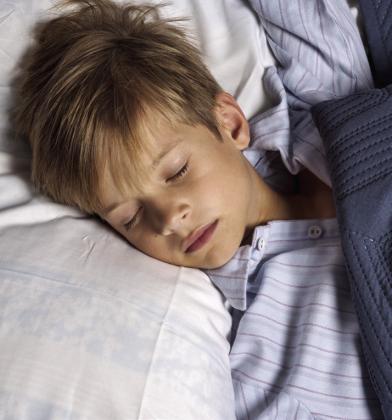MOST CHILDREN STOP BEDWETTING by four years old. However, 15%–20% of 5-year-old children continue to wet the bed. Involuntary urination during sleep is called nocturnal (i.e., nighttime) enuresis (pronounced “EN-yoo-REE-sis”). The American Academy of Sleep Medicine considers a child to have nocturnal enuresis if the child is five years or older, has bedwetting at least twice weekly, and the bedwetting has occurred for at least three months.
Some common factors that can contribute to bedwetting are medications, foods (e.g., watermelon, caffeine), stress (e.g., parental discord or divorce), type 1 or type 2 diabetes, and bladder infection. However, an often-overlooked factor is obstructive sleep apnea, a disorder in which a child intermittently stops breathing briefly during sleep. The cessation in breathing (i.e., apnea [pronounced “AP-nee-uh”]) occurs because the muscles in the upper airway relax too much during sleep, which allows tissues such as tonsils and adenoids to collapse into the airway and block (i.e., obstruct) airflow. Owing to the reduced airflow, a child makes increasingly strong efforts to breathe. The child ultimately arouses for a few seconds, during which the upper airway opens, and the child is able to take some deep breaths. Snoring and gasping may occur during this arousal. Frequent arousals from sleep can result in effects such as daytime sleepiness and problems associated with sleepiness such as difficulty concentrating, behavioral problems, and poor school performance.
Scientists are unsure how obstructive sleep apnea contributes to bedwetting in children. One thought is that, with each effort to breathe during an apnea episode, the lungs press excessively against the heart, which causes the heart to release a chemical that causes the kidneys to increase their urine production. Another thought is that frequent arousals from sleep disrupt the interaction between various chemicals that would normally work together to maintain fluid balance. The disrupted interaction results in increased urine production during sleep. For now, scientists continue research to understand the connection between bedwetting and obstructive sleep apnea.
Your child may benefit from being evaluated at a sleep center to rule out obstructive sleep apnea if, in addition to bedwetting, the following symptoms exist:
• Behavioral problems
• Daytime sleepiness
• Difficulty concentrating
• Falling asleep during classes in school
• Mouth breathing
• Poor school performance
• Snoring • Witnessing your child stopping breathing or struggling to breathe during sleep. If your child is determined to have obstructive sleep apnea, then treating it may reduce or eliminate episodes of bedwetting. The most common treatment for obstructive sleep apnea in children is positive airway pressure, in which slightly pressurized air is blown through the upper airway via a mask that fits over the nose or nose and mouth. The pressure of the air prevents upper airway tissues from collapsing into the airway, thereby eliminating apnea.
Bedwetting impacts a child socially (e.g., unable to enjoy sleepovers), physically (e.g., rash from wet underwear), and emotionally (e.g., embarrassment). Addressing factors such as obstructive sleep apnea that could be contributing to bedwetting could reduce the number of bedwetting episodes and improve a child’s quality of life.
Regina Patrick, RPSGT, RST, is a freelance writer/editor and is a registered sleep technologist. She has been involved in the sleep field for more than 30 years.
✲


